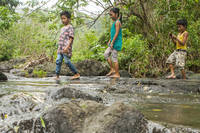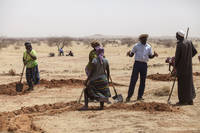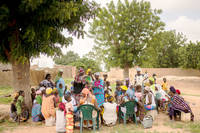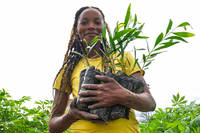Key messages
Healthy forests mean healthy people.

Forests provide health benefits for everyone, such as fresh air, nutritious foods, clean water, and space for recreation. In developed countries, up to 25 percent of all medicinal drugs are plant-based; in developing countries, the contribution is as high as 80 percent.
Forest food provides healthy diets.

Indigenous communities typically consume more than 100 types of wild food, many harvested in forests. A study in Africa found that the dietary diversity of children exposed to forests is at least 25 percent higher than that of children who are not. Forest destruction, on the other hand, is unhealthy – nearly one in three outbreaks of emerging infectious disease are linked to land-use change such as deforestation.
Restoring forests will improve our environment.

The world is losing 10 million hectares of forest – about the size of Iceland – each year, and land degradation affects almost 2 billion hectares, an area larger than South America. Forest loss and degradation emit large quantities of climate-warming gases, and at least 8 percent of forest plants and 5 percent of forest animals are at extremely high risk of extinction. The restoration and sustainable management of forests, on the other hand, will address the climate-change and biodiversity crises simultaneously while producing goods and services needed for sustainable development.
Sustainable forestry can create millions of green jobs.

Forests provide more than 86 million green jobs and support the livelihoods of many more people. Wood from well-managed forests supports diverse industries, from paper to the construction of tall buildings. Investment in forest restoration will help economies recover from the pandemic by creating even more employment.
It is possible to restore degraded lands at a huge scale.

The Great Green Wall for the Sahara and the Sahel Initiative, launched by the African Union in 2007, is the most ambitious climate-change adaptation and mitigation response under implementation worldwide. It seeks to restore 100 million hectares of degraded land, sequester 250 million tonnes of carbon and create 10 million green jobs by 2030, while greening landscapes in an 8 000 km belt across Africa’s drylands. Vast areas of degraded land elsewhere would also become highly productive again if restored with local tree species and other vegetation.
Every tree counts.

Small-scale planting and restoration projects can have big impacts. City greening creates cleaner air and more beautiful spaces and has huge benefits for the mental and physical health of urban dwellers. It is estimated that trees provide megacities with benefits worth USD 0.5 billion or more every year by reducing air pollution, cooling buildings and providing other services.
Engaging and empowering people to sustainably use forests is a key step towards positive change.

A healthy environment requires stakeholder engagement, especially at the local level so that communities can better govern and manage the land on which they depend. Community empowerment helps advance local solutions and promotes participation in ecosystem restoration. There is an opportunity to “rebuild” forest landscapes that are equitable and productive, and that avert the risks to ecosystems and people posed by forest destruction.
We can recover from our planetary, health and economic crisis. Let’s restore the planet this decade.

Investing in ecosystem restoration will help in healing individuals, communities and the environment. The aim of the UN Decade on Ecosystem Restoration, which starts this year, is to prevent, halt and reverse the degradation of ecosystems worldwide. It offers the prospect of putting trees and forests back into degraded forest landscapes at a massive scale, thereby increasing ecological resilience and productivity. Done right, forest restoration is a key nature-based solution for building back better and achieving the future we want.
